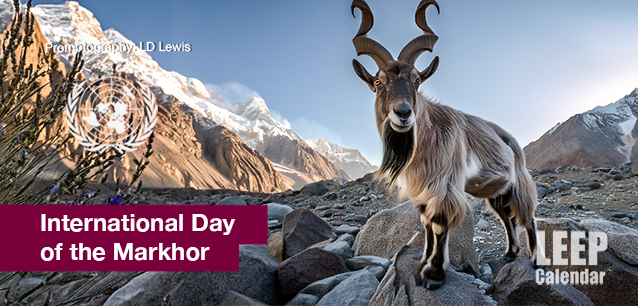 AD
AD
Today is: December 13
Scroll to explore events active on this date.
Additional Events on LEEP
LEEP INK FEATURES

August? Absolutely!
In August, we live through the Dog Days of Summer. It's hot and often humid, and those who can leave for better climates do. Down south, winter is in full force. August is also known as "the ...

In The Heat of July: July 2025 Events
Is it hot enough (or cold enough if you're below the equator) for you yet? There is actually a day for that! Like every month, I pick a diverse collection of events you may or may not know about. This ...

May Blooms: Events in May 2025
Along with October, May is one of the most densely packed months of the year. It's before the summer humidity and the last whole month of the school year. The weather is warming in t...
About International Day of the Markhor
South Asia
Ends: May 24, 2025
DESCRIPTION:
THE ORIGINAL G.O.A.T, GOAT:
INTERNATIONAL DAY OF THE MARKHOR
The International Day of the Markhor, observed annually on May 24, is dedicated to raising awareness about the markhor, a majestic wild goat species, and its conservation. The day highlights the importance of protecting this species and its habitat, promoting sustainable conservation practices, and engaging local communities in preservation efforts. Objectives of the event include:
Raise Awareness
Educate the public about the markhor, its ecological significance, and the threats it faces.
Promote Conservation
Support efforts to conserve the markhor and its habitat through sustainable practices.
Engage Communities
Involve local communities in conservation efforts and promote eco-friendly practices.
Highlight Success Stories
Share successful conservation initiatives to inspire further action and support.
WHAT IS A MARKHOR?
The markhor (Capra falconeri) is a large wild goat known for its impressive twisted horns, which can grow up to 1.5 meters long. It is Pakistan's national animal, and its striking appearance and agility are remarkable.
Markhors inhabit mountainous regions, primarily found in the following areas:
Pakistan: Northern and western mountain ranges.
Afghanistan: Eastern mountainous areas.
India: Northern regions.
Tajikistan: Mountainous terrain.
The markhor is classified as Near Threatened by the International Union for Conservation of Nature (IUCN). The primary threats to its survival include habitat loss, hunting, and competition with domestic livestock. Conservation efforts have shown positive results, increasing some populations, but continued vigilance is necessary.
HISTORY OF THE EVENT
International Day of the Markhor was established by conservation organizations and wildlife enthusiasts to draw global attention to the plight of the markhor. The date, October 12, was chosen to coincide with the start of the markhor breeding season, emphasizing the importance of protecting the species during this critical period.
The event gained official recognition from various wildlife conservation groups and governments in regions where the markhor lives. It serves as an annual reminder of the ongoing efforts needed to protect this iconic species.
HOW TO PARTICIPATE
People worldwide, especially in regions where the markhor lives, participate in various activities to support the conservation of this species. Common activities include:
Educational Programs
Schools, universities, and wildlife organizations conduct seminars and workshops to educate the public about the markhor and its ecological importance.
Conservation Campaigns
Awareness campaigns through social media, posters, and public speeches highlight the threats facing the markhor and the need for conservation.
Community Involvement
Local communities plant trees, restore habitat, and engage in eco-friendly practices to support markhor conservation.
Fundraising Events
Fundraising drives and charity events support conservation projects and initiatives to protect the markhor.
Wildlife Tours
Eco-tourism and guided wildlife tours in regions where markhors promote sustainable tourism and raise funds for conservation efforts.
The International Day of the Markhor plays a significant role in bringing global attention to the conservation needs of this unique species. By promoting awareness and engaging communities, the event helps to ensure that the markhor and its habitat flourish for future generations. The day also highlights the importance of biodiversity and the need for sustainable conservation practices worldwide.
VIDEOS
SUPPORTING DOCUMENTS
Currently, this event does not have supporting documents.
ADDITIONAL IMAGES
Currently, this event does not have supporting images.
Where would you like to go now?
 AD
AD


/footer-logo.svg)
